요약2012년 남해안에 내습한 태풍 산바에 의해 발생한 폭풍해일과 파랑을 JMA-MSM 예보기상자료, NCEP-CFSR 재분석 기상자료, ECMWF-ERA5 재분석 기상자료, JTWC의 최적경로를 이용한 기상자료를 이용하여 수치모의하고, 계산된 해일고를 전국 해안의 항만에서 관측된 폭풍해일 시계열 자료와 비교하였으며, 파랑에 대해서는 계산된 유의파고를 해상 부이 및 수압식 파고 관측 자료와 비교하였다. 이 비교를 통해 태풍 산바에 대한 각종 기상장의 신뢰도를 평가하였다. 그 결과 JMA-MSM 기상자료와 NCEP-CFSR 기상자료가 가장 신뢰도가 높았고, ECMWF-ERA5 기상자료는 전반적으로 해일고나 파고의 크기가 작게 나타났으나, 태풍 전면부의 수렴대는 가장 잘 재현하는 것으로 나타났다. JTWC의 최적경로를 이용한 기상자료는 신뢰도가 가장 낮게 나타났다.
AbstractNumerical simulations of the storm surge and the wave induced by the Typhoon Sanba incident on the south coast of Korea in 2012 are conducted using the JMA-MSM forecast weather field, NCEP-CFSR reanalysis weather field, ECMWF-ERA5 reanalysis weather field, and the pressure and wind fields obtained using the best track information provided by JTWC. The calculated surge heights are compared with the time history observed at harbors along the coasts of Korea. For the waves the calculated significant wave heights are compared with the data measured using the wave buoys and the underwater pressure type wave gauge. As a result the JMA-MSM and the NCEP-CFSR weather fields give the highest reliability. The ECMWF-ERA5 gives in general surge and wave heights weaker than the measured. The ECMWF-ERA5, however, reproduces the best convergence belt formed in front of the typhoon. The weather field obtained using JTWC best track information gives the worst agreement.
1. 서 론항만 외곽 방파제에 대한 설계파는 방파제 구조물의 안정성 검토를 위한 파압 산정과 방파제 배후 시설물 방재대책 수립에 필수적인 월파량 산정에 있어서 필수적인 설계 입력 자료이다. 해안 구조물 설계파는 구조물 설치 위치에서 장기간에 걸친 관측자료를 빈도분석하여 구하는 것이 일반적이다. 그러나 우리나라 해안에서 장기간의 파랑 관측자료가 존재하는 경우가 거의 없으므로, 장기간의 관측자료 또는 재분석 자료가 풍부한 기상장을 이용하여 구조물 위치에서의 파랑을 직접 추산하는 방법이 고려되고 있다. Yoon et al.(2020)은 우리나라 역사상 가장 강력했던 태풍으로 알려진 태풍 매미(0314)에 의해 발생했던 파랑과 폭풍해일을 일본 기상청(JMA, Japan Meteorological Agency)의 JMA-MSM, 미국 국립환경예측센터(NCEP, National Centers for Environmental Prediction)의 NCEP-CFSR, 유럽 중규모기상예보센터(ECMWF, European Centre for Medium-Range Weather Forecasts)의 ECMWF-ERA5 및 미국 합동태풍경보센터(JTWC, Joint Typhoon Warning Center)의 JTWC-best trac k 기반 기상장 등의 4가지 대표적인 기상장을 이용하여 수치모의하고 관측치와 비교하여 각종 기상장의 신뢰도를 평가한 바 있다.
2003년 태풍 매미의 내습 당시 우리나라에서는 파랑 및 폭풍해일 관측이 거의 이루어지지 않아 관측자료의 부족으로 합리적인 기상장의 신뢰도 분석에는 부족한 점이 있었다. 또한 NCEP-CFSR 재분석 기상장은 ver.1으로 해상도가 낮아 다른 기상장에 비해 신뢰도가 매우 낮게 나타났다. 2011년부터 NCEP-CFSR 재분석 기상장은 ver. 2로 바뀌면서 Table 1에 제시한 바와 같이 해상도가 0.205° × 0.204°로 높아져 현재에 이르고 있다. 따라서 대표적인 기상장의 현재 상태의 신뢰도를 분석하기 위해서는 2011년 이후의 태풍에 대한 검토가 필요하다. 또한 2003년 태풍 매미의 피해를 입은 다음 꾸준한 파랑관측에 대한 필요성이 제기되고 예산이 일부 확보되면서 기상청과 국립해양조사원을 중심으로 해양 파랑 관측부이가 설치되기 시작하여 2012년 태풍 산바(1216) 내습 시에는 상당히 많은 파랑 관측자료가 확보되었다.
본 연구에서는 2012년의 태풍 산바에 대한 파랑 및 폭풍해일 수치모의를 통해 각종 기상장의 신뢰도를 평가하고자 한다. 각종 기상장에 대한 일반적인 설명은 Yoon et al.(2020)에 제시한 바 있으므로 생략한다. 한편 미국 합동태풍경보센터(JTWC)에서 제공하는 최적경로(best track, 이후부터 JTWC-BT로 간단히 표기) 정보를 이용한 바람장은 폭풍해일 수치 모형인 ADCIRC에서 option NWS = 19(Dynamic asymmetric model)를 선택하여 Suh and Kim(2012)에서 사용한 바와 같은 동적 비대칭 바람장을 구하였다. 최적경로 파라미터를 사용하여 기압장과 바람장을 생성하는 방법은 종래에는 대칭형 바람장을 사용하여 왔으나 근래 비대칭 바람장으로 개선되었으며, 2가지 방법에 대한 차이는 Kim et al.(2020)에서 다룬바 있다. 최적경로 파라미터를 이용하는 방법은 Kim et al. (2020)에서 지적한 바와 같이 활용된 바람장 모형에 따라 결과가 매우 다르게 나타날 수 있다. 또한 동일한 기관에서 제공하는 기상장일지라도 모든 태풍 사상에 대해 동일한 신뢰성을 가지는 것은 아니며, 태풍 사상, 사용하는 폭풍해일 수치모형 및 파랑 수치모형에 따라 결과가 매우 폭 넓게 나타날 수 있으므로 사용 전 검증이 필요하다.
2. 기상장
Fig. 1은 태풍연구센터(Typhoon Research Center, www.typhoon.or.kr)에서 제공하는 태풍 산바의 이동경로와 풍속 25 m/s 및 15 m/s의 영향범위이다. 본 연구에서 제시되는 시간은 UTC(Coordinated Universal Time)로 통일하였다. 태풍 산바는 2012년 9월 10일 필리핀 남동쪽 먼 해상에서 발생하여 필리핀 동쪽 근해상까지 북서진한 다음, 동경 130도선을 따라 북진하면서 9월 13일 중심기압 910 hPa, 10분 지속 평균 풍속 57 m/s(110 kt)의 강력한 태풍으로 발달하였다. 그 후 제주도 동쪽을 지나 계속 북진하여 남해안의 남해에 상륙하였다. 태풍 산바는 남해안 상륙 시까지도 강한 태풍을 유지하여 전라남도와 경상남도 해안에 큰 피해를 입힌 다음, 동해안의 강릉을 지나 북동진하여 동해상으로 빠져나갔다.
Fig. 2는 태풍 산바가 제주도에 영향을 미치기 시작한 2012년 9월 16일 18:00시의 기압분포를 각 기상장에서 추출하여 보인 것이다. JMA-MSM, NCEP-CFSR 및 ECMWF-ERA5 에 의한 기압장은 유사한 분포를 보이나, JTWC-BT의 기압장은 태풍에 의한 중심부 기압 강하 영역이 매우 좁게 나타났다. Fig. 3은 Fig. 2와 동일한 시간에 대해 각 기상장에서 제공하는 바람장을 보여주는 바, JMA-MSM과 NCEP-CFSR은 소용돌이(vortex) 바람이 강하게 나타났으나, ECMWF-ERA5 바람은 상대적으로 약하게 나타났다. 한편 JTWC-BT는 태풍 중심부의 풍속은 강하게 나타났으나, 강풍의 영향 영역이 좁고 특히 태풍의 북동쪽에서 태풍 중심부로 이끌려오는 태풍 전면부 수렴대의 바람이 전혀 나타나지 않았다.
Fig. 4는 태풍 산바가 남해안에 상륙하기 직전인 2012년 9월 17일 02:00시 (UTC)의 기압분포를 각 기상장에서 추출하여 보인 것이다. JMA-MSM, NCEP-CFSR 및 ECMWF-ERA5 기압장은 유사한 분포를 보이나 NCEP-CFSR과 ECMWF-ERA5의 중심부 기압 강하는 약하게 나타났다. JTWC-BT의 기압장은 태풍에 의한 기압 강하 영역이 상대적으로 좁게 나타났다. Fig. 5는 Fig. 4와 동일한 시간에 대해 각 기상장에서 제공하는 바람장을 보여주는 바, JMA-MSM, NCEP-CFSR과 ECMWF-ERA5 바람은 강도에 차이는 있으나 전반적인 바람의 분포 양상은 유사하게 나타났다. 한편 JTWC-BT 바람장은 태풍 중심부로부터 멀리 떨어진 동해 중부와 북부 해역의 태풍 전면 수렴대에 의한 북동풍이 전혀 나타나지 않아 전반적인 바람의 분포가 다른 기상장과 큰 차이를 보인다. 이 당시 동해 해역에는 기상청의 동해 해양기상부이와 포항 해양 기상부이, 국립해양조사원의 왕돌초 해양관측소, Jeong(2017)의 속초 수압식 파고계 등이 설치되어 있었던 바, JTWC-BT 바람장에 의한 파고는 관측자료와 상당한 차이를 보일 것으로 예상된다.
Fig. 6은 태풍 산바가 동해로 진출한 2003년 9월 17일 12:00시 (UTC)의 기압분포를 각 기상장에서 추출하여 보인 것이다. JMA-MSM, NCEP-CFSR 및 ECMWF-ERA5에 의한 기압장은 유사한 분포를 보이나, JTWC-BT의 기압장은 태풍에 의한 중심부 기압 강하 영역이 매우 좁게 나타났다. Fig. 7은 Fig. 6과 동일한 시간에 대해 각 기상장에서 제공하는 바람장을 보여주는 바, JMA-MSM, NCEP-CFSR과 ECMWF-ERA5는 풍속의 분포 형상이 유사하나 가항반원에서 NCEPCFSR의 북동풍이 더 강하게 나타났다. 반면 JTWC-BT의 바람은 가항반원에서의 북동풍이 거의 나타나지 않아 전반적인 형상이 앞의 3가지 바람장과 크게 다르게 나타났다. JTWC-BT에 의한 바람장은 다른 기상장과 달리 몇 가지 태풍 파라미터만으로 바람장을 경험공식으로 도출하므로 주변 지형이나 배경 기상장의 영향이 고려되지 못하기 때문인 것으로 판단된다. 특히 Kwon et al.(2020)의 태풍 콩레이와 Yoon et al.(2020)의 태풍 매미의 경우에서 보인 바와 같이 JTWC-BT 바람장은 태풍이 한반도를 벗어나 동해로 진출할 때 이동속도가 빨라지면 가항반원의 바람이 과소평가되는 경향이 있다.
3. 파랑 및 폭풍해일 수치모의이상에서 살펴본 바와 같이 각종 기상장은 사용된 수치기법과 공간해상도 및 자료동화 기법 등의 차이로 서로 다른 결과를 준다. 어느 기상장이 더 우수한지는 관측 자료와의 비교를 통해 판단할 수 있다. 본 연구에서는 태풍 산바에 의한 파랑과 폭풍해일을 수치모의하고 관측치와의 비교를 통해 각종 기상장의 타당성을 평가하고자 한다.
폭풍해일을 수치모의하기 위한 수치모형으로 Luettich et al. (1992, 1994)에 의해 개발되어 전 세계적으로 널리 보급된 ADCIRC ver.53.04를 선정하였다. 한편 파랑 재현을 위한 수치모형으로는 Delft University에서 개발한 유한요소모형인 unSWAN ver.41.10을 이용하였다(Booij et al., 1999, SWAN team, 2016). 이 수치모형들의 자세한 지배방정식과 수치기법에 대해서는 다양한 연구논문 등을 통해 잘 정립되어 있으므로 생략한다. 폭풍해일과 파랑 수치모의 시 바닥마찰과 기타 모든 상수는 원래 ADCIRC와 unSWAN에서 제공하는 기본 값을 조정하지 않고 그대로 사용하였다. 또한 unSWAN을 이용한 파랑 수치모의 시 Komen et al.(1984)의 바람 에너지 전달 관계식을 선택하였다.
Fig. 8은 폭풍해일과 파랑을 수치모의하기 위한 유한요소망을 보여준다. 총 173,202개의 요소와 총 93,486개의 절점을 사용하였다. Fig. 9는 수치모의 결과와 관측치를 비교하는 정점의 위치를 보여주는 바, 폭풍해일에 대해서는 태풍의 강풍 영역인 제주도 해역에 위치하는 주요 항을 포함하여 남해안과 동해안의 항만 등 총 16개 정점에서 관측된 조위 관측 기록으로부터 예상조위를 제거한 순수 폭풍해일 시계열(Korea Hydrographic and Oceanographic Agency, 2012)과 수치모의 결과를 비교하였으며, 파랑에 대해서는 기상청에서 운영하는 해양기상부이와 근해 파고부이 관측점, 국립해양조사원의 파고부이 및 Jeong(2017)의 독자적인 수압식 파고 관측점 등 총 16개 정점에서 관측된 유의파고를 수치모의 결과와 비교하였다. Fig. 9에 제시된 관측 위치의 약어는 폭풍해일에 대해 각각 SC(속초), MH(묵호), HP(후포), PH(포항), US(울산), PS(부산), GDD(가덕도), GJD(거제도), MS(마산), GY(광양), GH-BP(고흥-발포), GMD(거문도), JJ(제주), SSP(성산포), SGP(서귀포), ULD(울릉도)를 나타내며, 파랑에 대해서는 SC (속초), DH(동해), ULD(울릉도), WDC(왕돌초), PH(포항), JH(진하), JA(장안), HUD(해운대), GA(광안), PS-North Port (부산 북항), PS-South Port(부산 남항), KS(대한해협), GJD (거제도), ESS(남해 동부), JS(제주해협), MRD(마라도)를 각각 의미한다. 2012년도에는 2003년의 태풍 매미로 인한 피해로 파고관측에 대한 관심이 고조되어 여러 기관에서 파고부이를 다수 설치하여 관측자료가 비교적 풍부하며, 당시 입수 가능한 파고 관측 자료는 모두 비교에 사용되었다.
4. 결과 및 분석폭풍해일은 기압과 바람의 복합 작용으로 발생하는 반면, 파랑은 바람에 의해서만 발생한다. 따라서 파랑장에 대한 관측치와의 비교를 통해 바람장의 신뢰성을 먼저 파악하고 나면, 후속되는 폭풍해일 수치모의에서 기상장과 수치모의의 정밀도 검증 시 기압장의 기여도를 따로 평가할 수 있어 편리하다. 그러므로 파랑 수치모의를 먼저 수행하고 관측치와 비교하여 평가하였다.
Fig. 10은 태풍 산바가 통과하면서 영향을 미치는 제주도 인근 해역에 위치하는 마라도와 제주해협 파고부이에서 관측된 유의파고와 수치모의에 의한 유의파고를 비교한 것이다. 마라도와 제주해협 파고부이는 태풍의 이동경로 좌측의 가항반원에 위치하여 바람이 상대적으로 약하므로 관측파고가 6 m 이내로 나타났다. JMA-MSM과 NCEP-CFSR 바람장은 전반적으로 파고가 과대평가되었고, JTWC-BT 바람장은 파랑의 전반적인 발달과 감쇄 과정을 잘 재현하지 못하고 있다. 반면 ECMWF-ERA5 바람장은 관측파고와 잘 일치하였다. 이로부터 JMA-MSM과 NCEP-CFSR 바람장은 가항반원에서의 바람이 실제보다 과대평가되었음을 알 수 있다. 이 가항반원에서의 바람은 Fig. 3에 보인 바와 같이 태풍 중심이 제주도에 도달하기 전 태풍의 전면부에서 반시계 방향으로 부는 북풍 또는 북동풍에 해당한다. 따라서 향후 더 좋은 바람장을 얻기 위한 태풍 재분석 시 이를 고려하는 것이 요구된다.
Fig. 11은 태풍 산바가 상륙한 남해안 해역에 위치하는 파고부이에서 관측된 유의파고와 수치모의에 의한 유의파고를 비교한 것이다. 모든 관측점들이 태풍의 위험반원에 위치하여 높은 파고가 관측된 바, 태풍의 최대풍 반경에 놓인 남해 동부 파고부이에서 약 10.7 m, 거제도 부이에서 9.6 m의 유의파고가 기록되었다. 한편 JMA-MSM과 NCEP-CFSR 바람장을 이용한 계산치는 파고 첨두치가 관측치와 비슷하거나 약간 크게 나타났다. JTWC-BT에 의한 바람장은 파랑의 발달과 감쇄 과정은 관측치와 매우 다르게 나타났으나 파고 첨두치는 다른 바람장에 의한 파고와 비슷하거나 약간씩 크게 나타났다. ECMWF-ERA5 바람장에 의한 파고는 전반적인 발달과 감쇄 과정은 다른 바람장보다 관측치에 더 잘 일치하나, 파고 첨두치가 과소평가되는 것으로 나타났다.
Fig. 12는 동해안 해역에 위치하는 파고부이에서 관측된 유의파고와 수치모의에 의한 유의파고를 비교한 것이다. 각종 바람장을 이용하여 계산된 파고 시계열은 울릉도 부이 계산치를 제외하면 관측치와 상당히 다른 양상을 보인다. 특히 포항, 왕돌초와 동해 부이 관측점에서 태풍이 통과하기 전인 9월 16일 12:00시에서 17일 06:00시 사이의 기간에서 파고가 과소평가되는 경향이 나타났다.
이는 Fig. 13에서 보인 바와 같이 태풍이 남해안에 상륙할 당시인 9월 17일 02:00시 경 동해 해역에서는 태풍 전면부의 수렴대(convergence belt)가 형성되어 수렴대의 북쪽 해역에서 북동풍이 강하게 부는 현상과 관련이 있다. JMA-MSM 바람장은 수렴대가 가장 북쪽에 형성되어 속초(SC)를 제외한 동해(DH), 왕돌초(WDC) 및 포항(PH) 관측점이 수렴대의 약한 바람 영역에 위치하므로 파고가 관측치보다 작게 나타났다. 진하(JH) 관측점은 태풍의 영향으로 바람이 상대적으로 강해 파고가 실제보다 크게 나타났다. 울릉도(ULD)는 약한 바람 영역에 위치하여 파고가 관측치와 근접하게 나타났다. NCEP-CFSR 바람장은 수렴대가 JMA-MSM 보다는 약간 남쪽에 형성되어 왕돌초와 포항 부이가 수렴대 북쪽의 북동풍 영역에 들어가 파고가 증가하기 시작하였으나, 동해 부이는 여전히 수렴대의 약한 바람 영역에 머물러 파고가 작게 계산되었다. ECMWF-ERA5 바람장은 수렴대가 가장 남쪽에 형성되어 속초, 동해, 왕돌초와 포항 부이가 모두 수렴대 북측의 강한 바람 영역에 들어가 파고가 다른 바람장에 비해 크게 계산되어 관측치와 가장 근접하게 나타났다. 또한 진하와 울릉도 관측점은 수렴대의 약한 바람 영역에 위치하여 파고가 작게 계산되어 관측치와 전반적인 경향이 잘 일치한다. JTWC-BT 바람장은 태풍 전면부의 수렴대가 나타나지 않아 실제와 매우 다른 결과를 보인다. 이상의 4가지 바람장에 대한 파고 비교로부터 ECMWF-ERA5 바람장이 태풍 전면부 수렴대를 가장 잘 재현하여 전반적으로 가장 우수한 결과를 보였다. ECMWF-ERA5 바람장에서 한 가지 아쉬운 점은 수렴대 북측의 북동풍 강도가 실제보다 약간 약하다는 점으로서 향후 태풍 재분석 시 고려되어야 할 사항이다.
바람장에 대한 평가가 이루어진 상태에서 기압장의 신뢰도를 평가하기 위해 폭풍해일 수치모의를 수행하고 관측치와 비교하였다. Fig. 14는 제주도 해안에 위치하는 서귀포항, 성산포항과 제주항, 그리고 남해안의 서부에 위치하는 거문도항, 고흥-발포항과 광양항에서 태풍 산바 내습 시 관측된 폭풍해일고의 시계열과 각종 기상장을 사용하여 ADCIRC 수치모형에 의해 계산된 폭풍해일고 시계열을 비교한 것이다. 태풍 산바는 제주도의 동쪽 해역을 통과하여 비교 대상인 6개 항구는 태풍의 가항반원에 위치하므로 해일고는 제주도 해안과 거문도항에서 최대 0.6 m 정도이며, 수심이 상대적으로 작고 태풍 이동 경로에 가까운 광양항에서는 1.1 m 정도이다. 그림에 보인 바와 같이 JMA-MSM 기상장과 NCEP-CFSR 기상장은 해일고를 전반적으로 잘 재현하고 있으나, ECMWF-ERA5 기상장은 해일고 첨두치가 상당히 작게 계산되었다. JTWC-BT 기상장은 Fig. 2(d)에 보인 바와 같이 태풍 중심부 기압 강하 영역이 매우 좁아 전반적으로 해일고를 과소평가하고 있다. 제주도 근처 해역에서 파랑을 과대평가했던 JMA-MSM 기상장과 NCEP-CFSR 기상장이 해일고 관측치를 잘 재현하고 있는 걸로 미루어보아 이 지역에서의 해일고는 바람에 의한 취송효과 보다는 기압 강하에 의한 해수면 상승이 더 크게 작용하는 것으로 보인다.
Fig. 15는 태풍이 상륙한 남해 동부해안에 위치하는 마산항, 가덕도항, 거제도항과 부산항에서 관측된 폭풍해일고의 시계열과 각종 기상장을 사용하여 ADCIRC 수치모형에 의해 계산된 폭풍해일고 시계열을 비교한 것이다. JMA-MSM 기상장과 NCEP-CFSR 기상장은 전반적으로 해일고를 잘 재현하고 있다. JTWC-BT 기상장은 전반적으로 해일고를 과대평가하고 있으며, 특히 마산항에서는 해일고가 다른 기상장에 비해 과도하게 크게 계산되었다. 이는 JTWC-BT 기상장이 주변 육지지형을 고려하지 않고 모두 바다로 간주하므로 풍속이 진해만에서 마산만으로 이어지는 해역에서 강하게 나타났기 때문으로 판단된다. ECMWF-ERA5 기상장은 바람장이 다른 3가지 기상장보다 약해 전반적으로 해일고가 과소평가 되었다.
마지막으로 Fig. 16은 동해안에 위치하는 울산항, 포항항, 후포항, 묵호항, 속초항과 울릉도항에서 관측된 폭풍해일고의 시계열과 각종 기상장을 사용하여 계산된 해일고 시계열을 비교한 것이다. 그림에 보인 바와 같이 4가지 기상장 모두 해일고를 약간씩 과소평가하고 있으며, 과소평가 정도는 남쪽으로 내려올수록 심해져 울산항과 포항항에서 가장 큰 차이를 보인다. Fig. 12에 보인 바와 같이 9월 16일 12:00시에서 17일 06:00시까지의 기간 동안 왕돌초와 포항 부이에서 수렴대에 의한 북동풍이 실제보다 약해 파고가 과소평가되었음을 고려하면 울산항, 포항항과 후포항에서 이 기간 동안에 해일고가 과소평가되었을 수도 있으나, Fig. 7에 보인 바와 같이 17일 12:00시 경부터는 태풍이 바다로 진출하여 태풍 이동경로의 남쪽 해안에서는 이안풍이 불기 시작하므로 바람에 의한 취송효과가 해수위를 하강시켜 해일고는 감소하는 것이 논리적이다. 그러나 관측된 해일고는 17일 하루 종일 고수위가 지속되는 경향을 보여 아직 파악하지 못한 다른 메커니즘이 있을 것으로 판단된다. 일반적으로 동해안에서의 해일고는 태풍이 지나간 뒤에도 상당 기간 동안 고수위가 지속되는 현상이 자주 발생한다. 이에 대한 심층 분석은 다음 연구 과제로 남겨둔다.
이상에서 각종 기상장의 파랑 및 폭풍해일 재현 능력을 계산치와 관측치의 시계열을 비교하여 정성적으로 검토하였다. 바람장을 이용한 파랑의 재현은 궁극적으로 방파제 등 외곽 시설물의 설계파를 구하기 위한 목적으로 시행되며, 구조물 설계파는 태풍 사상에 의한 파고 시계열 중 첨두치만을 사용한다. 또한 파의 월파량 산정에 적용되는 해일고는 첨두파 발생 시의 해일고가 중요하다. 따라서 본 연구에서는 각 파고관측점에서의 첨두 유의파고와 해일고만을 추출하여 계산치와 관측치를 비교하여 각 기상장의 종합적인 신뢰도를 평가한다. Fig. 17(a)는 16개 관측점에서의 관측 첨두파고와 계산첨두파고를 비교한 것이며, Fig. 17(b)는 16개 항만에서의 첨두 해일고(상승 및 하강)의 첨두치를 비교한 것이다. 또한 Table 2는 유의파고와 해일고 첨두치의 RMSE를 구한 결과이다.
이상에서 살펴본 바와 같이 JMA-MSM 기상자료가 가장 신뢰도가 높았고, NCEP-CFSR 기상자료도 상당히 우수하게 나타났다. ECMWF-ERA5 기상자료는 전반적으로 해일고나 파고의 크기가 작게 나타났으며, JTWC의 최적경로를 이용한 기상자료는 신뢰도가 가장 낮게 나타났다.
5. 결 론본 연구에서는 2012년 9월 남해안에 상륙하여 큰 피해를 입힌 태풍 산바에 의한 폭풍해일과 파랑을 수치모의하고, 관측치와의 비교를 통해 기상장의 신뢰도를 평가하였다. 기상장으로는 3차원 기상 수치모의에 의해 산출된 JMA-MSM 예보 기상장, NCEP-CFSR 기상장, ECMWF-ERA5 기상장과 JTWC 최적경로 기반 기상장을 사용하였다. 폭풍해일 수치모형으로는 유한요소모형인 ADCIRC를, 파랑 수치모형으로는 역시 유한요소모형인 unSWAN의 최신 버전(41.31)을 이용하였다. 본 연구를 통해 다음과 같은 결과를 얻을 수 있었다.
먼저 바람 만에 의해 결정되는 파랑에 대해 관측치와 계산치를 16개 정점에서 비교한 결과, JMA-MSM 기상장과 NCEPCFSR 기상장은 남해안의 넓은 해역에 걸쳐 파고 관측 자료를 비교적 잘 재현하였으나, 제주 해역에서는 파고가 과대평가되었고, 동해 해역에서는 파랑 발달 과정에서 태풍 전면부 수렴대에서의 북동풍이 약해 파고가 과소평가되었다. ECMWF-ERA5 바람장을 사용한 경우 파고의 성장과 소멸 과정은 관측치와 잘 일치하나 최대파고는 관측치보다 상당히 작게 계산되었다. 반면 JTWC 최적경로 기반 기상장은 남해안에서는 전반적으로 파고가 과대평가되고, 파랑의 성장과 소멸 과정이 실제와 매우 다르게 나타났다. 특히 태풍이 동해상으로 진출할 때 이동속도가 빨라지는 경우 바람장이 왜곡되어 신뢰성이 저하되었다.
한편 16개 항만에서 관측된 폭풍해일과 수치모의 결과를 비교한 결과, JMA-MSM 기상장과 NCEP-CFSR 기상장은 제주 해역과 대부분의 남해 해역에서 폭풍해일 시계열을 비교적 잘 재현하였으나, 동해안의 남부 해안에 위치하는 울산과 포항에서는 해일고가 약간 과소평가되었다. JTWC 최적경로 기반 기상장은 제주 해역과 남해 서부 해역에서는 해일고가 과소평가되고, 이동경로 우측의 위험반원인 남해 해역에서는 과대평가되었다. ECMWF-ERA5 기상장은 전반적으로 해일의 발달과 소멸 과정이 관측치와 잘 일치하나, 바람의 강도가 전반적으로 약해 전 해역에서 해일고가 과소평가되었다.
본 연구의 각종 기상장 신뢰도 평가 결과 JMA-MSM 기상장과 NCEP-CFSR 기상장이 가장 신뢰도가 높았고, JTWC의 최적경로를 이용한 기상장은 실제 관측치와 매우 다르게 나타났다. ECMWF-ERA5 기상장은 전반적으로 바람장이 약해 해일고나 파고의 크기가 작게 나타났으나, 태풍 전면부의 수렴대를 가장 잘 재현하여 동해 해역에서 파랑과 해일의 성장과 소멸 과정은 관측치와 잘 일치하는 좋은 결과를 보였다. 태풍 산바의 경우 대표적인 4가지 기상장 모두 관측치를 완벽히 재현하지는 못하고 있어 향후 기상장을 다시 재분석할 필요가 있는 것으로 판단된다.
Fig. 2.Comparison of pressure fields for Typhoon Sanba at 18:00 (UTC) on 16 Sept. 2012 (Unit, hPa): (a) JMA-MSM, (b) NCEP-CFSR, (c) ECMWF-ERA5, (d) JTWC best track (NWS = 19). 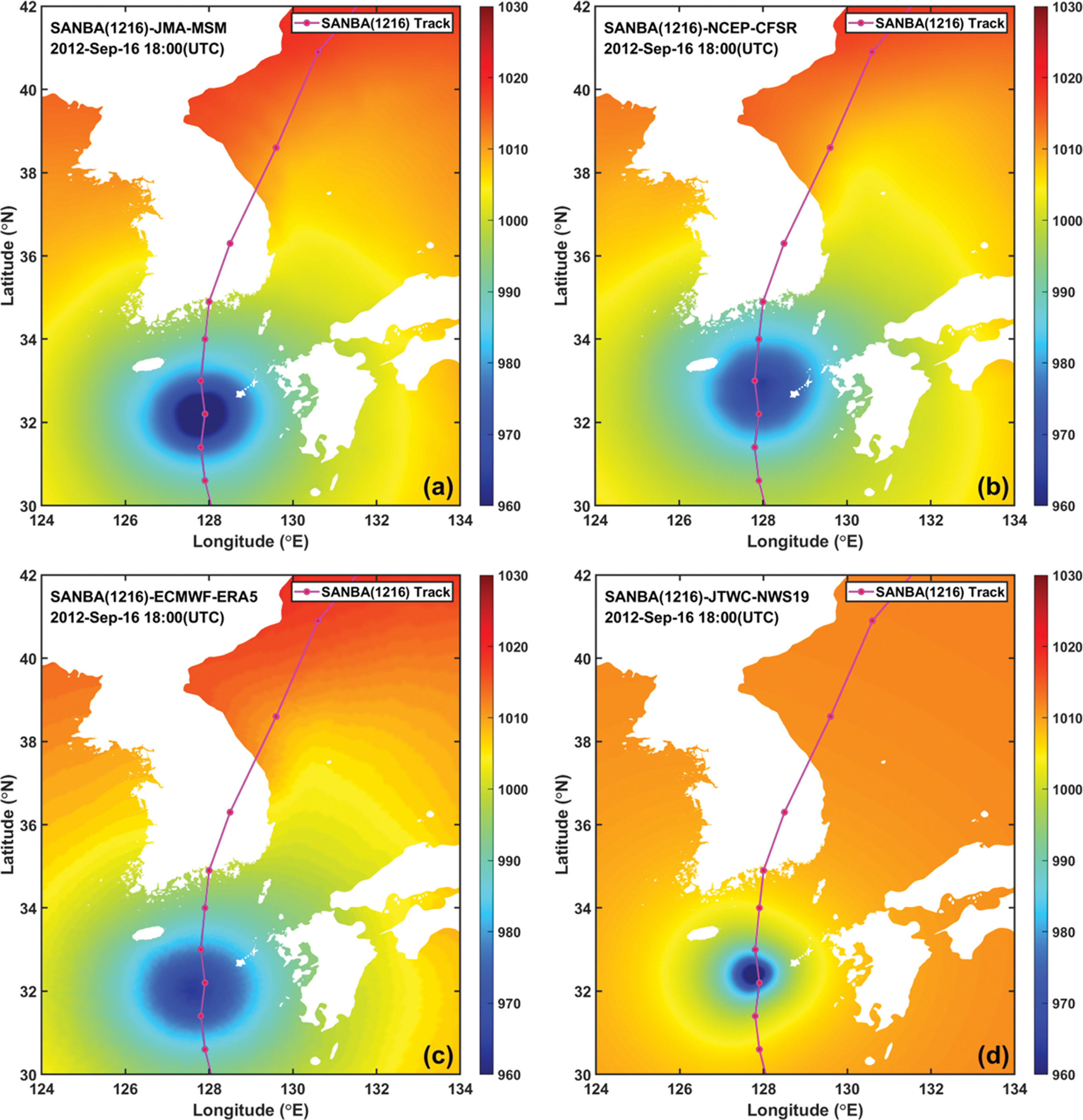
Fig. 3.Comparison of wind fields for Typhoon Sanba at 18:00 (UTC) on 16 Sept. 2012 (Unit, m/s): (a) JMA-MSM, (b) NCEP-CFSR, (c) ECMWF-ERA5, (d) JTWC best track (NWS = 19). 
Fig. 4.Comparison of pressure fields for Typhoon Sanba at 02:00 (UTC) on 17 Sept. 2012 (Unit, hPa): (a) JMA-MSM, (b) NCEP-CFSR, (c) ECMWF-ERA5, (d) JTWC-BT (NWS = 19). 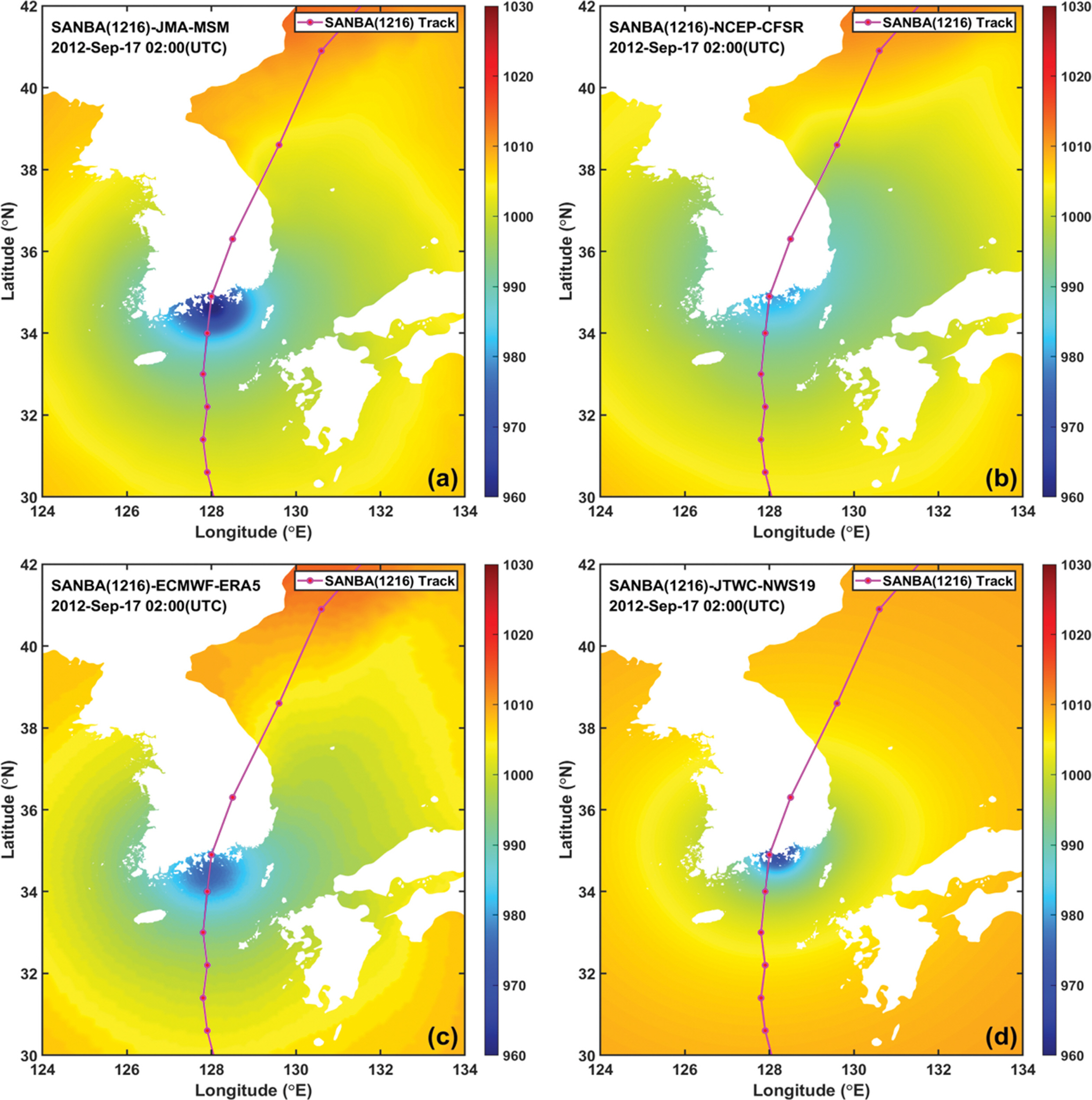
Fig. 5.Comparison of wind fields for Typhoon Sanba at 02:00 (UTC) on 17 Sept. 2012 (Unit, m/s): (a) JMA-MSM, (b) NCEP-CFSR, (c) ECMWF-ERA5, (d) JTWC-BT (NWS = 19). 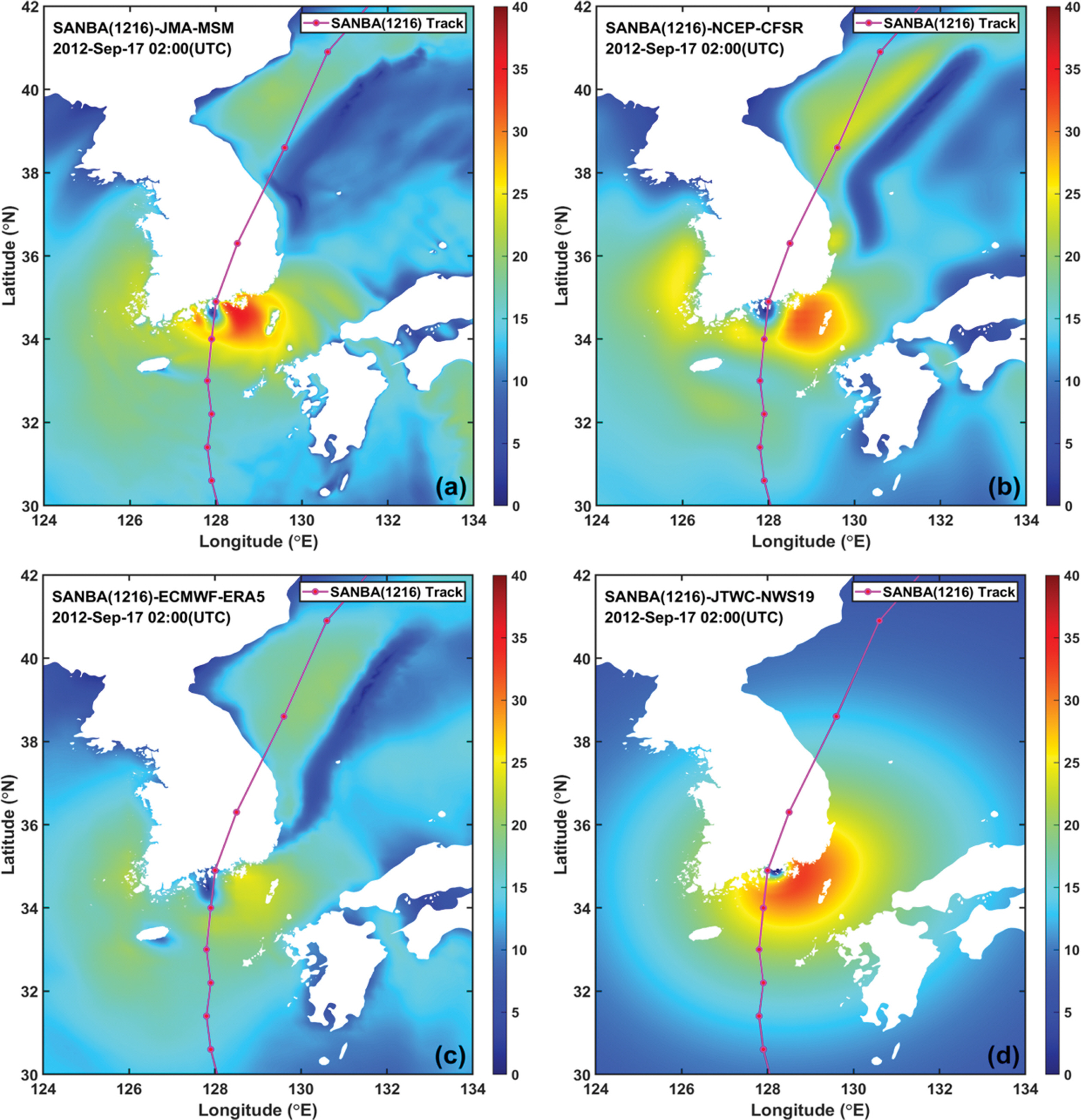
Fig. 6.Comparison of pressure fields for Typhoon Sanba at 12:00 (UTC) on 17 Sept. 2012 (Unit, hPa): (a) JMA-MSM, (b) NCEP-CFSR, (c) ECMWF-ERA5, (d) JTWC-BT (NWS = 19). 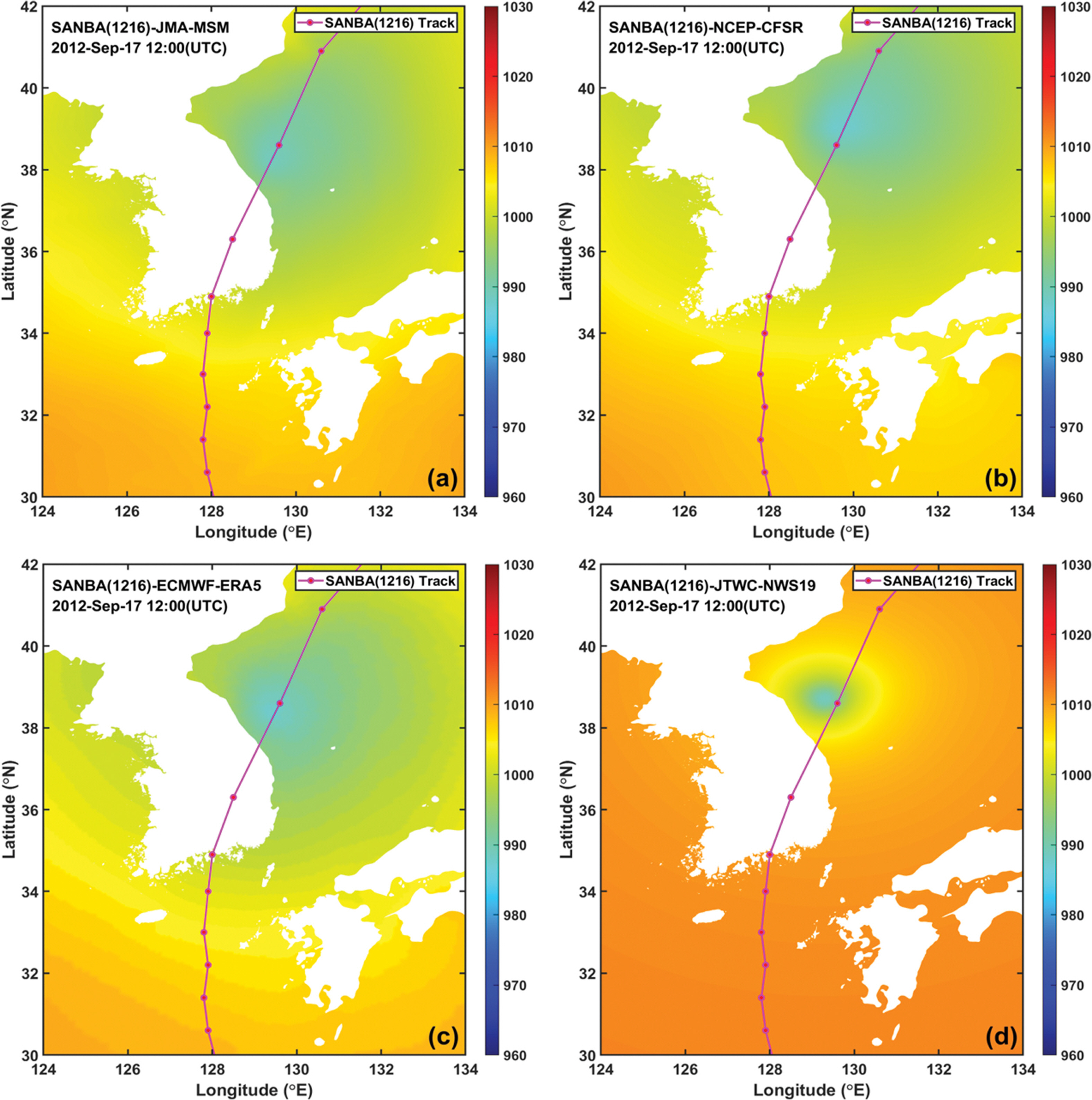
Fig. 7.Comparison of wind fields for Typhoon Sanba at 12:00 (UTC) on 17 Sept. 2012 (Unit, m/s): (a) JMA-MSM, (b) NCEP-CFSR, (c) ECMWF-ERA5, (d) JTWC-BT (NWS = 19). 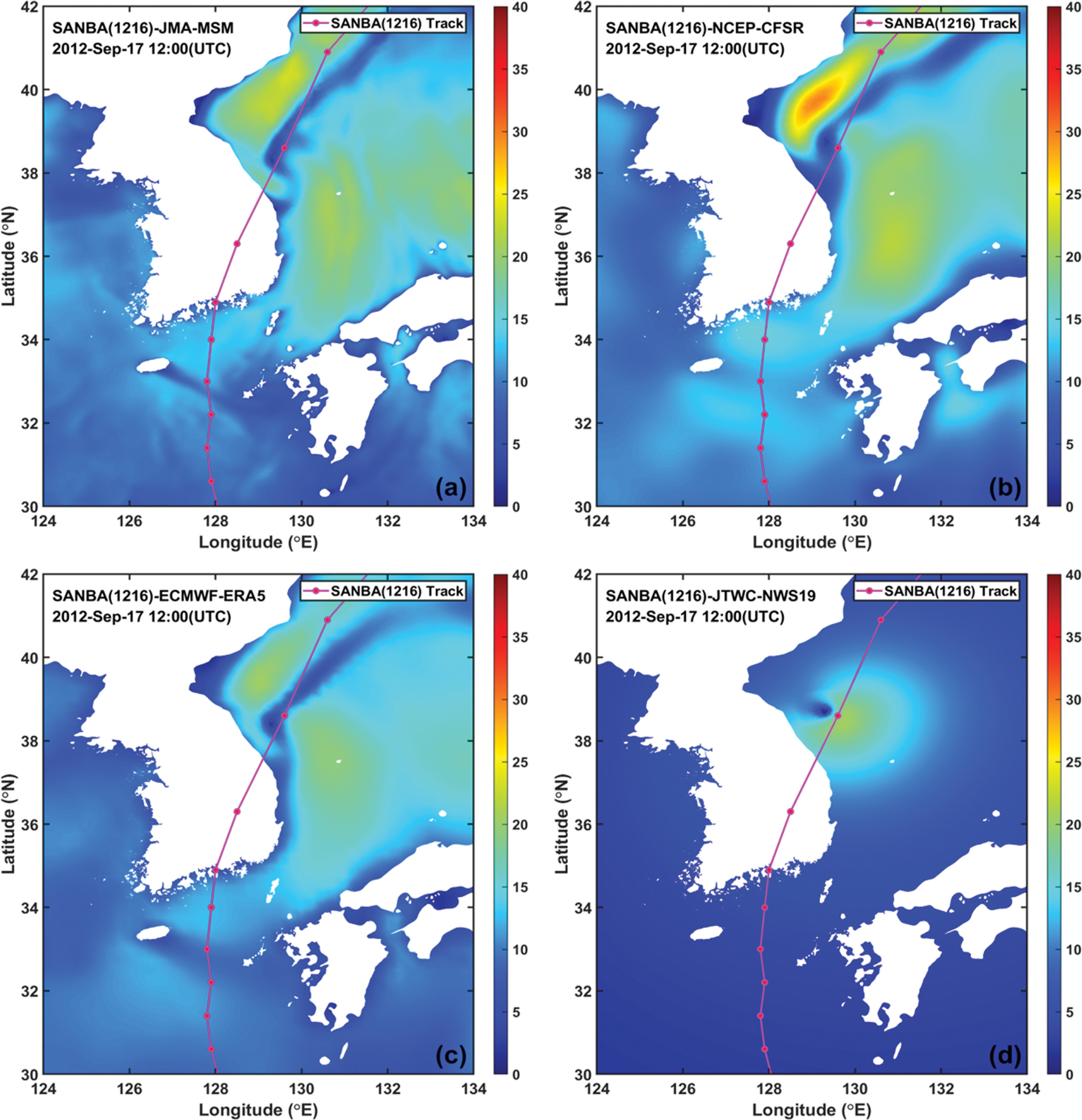
Fig. 10.Comparison of significant wave heights calculated using various wind fields against observed data at buoys near Jeju island for Typhoon Sanba. 
Fig. 11.Comparison of significant wave heights calculated using various wind fields against observed data at buoys on South Sea for Typhoon Sanba. 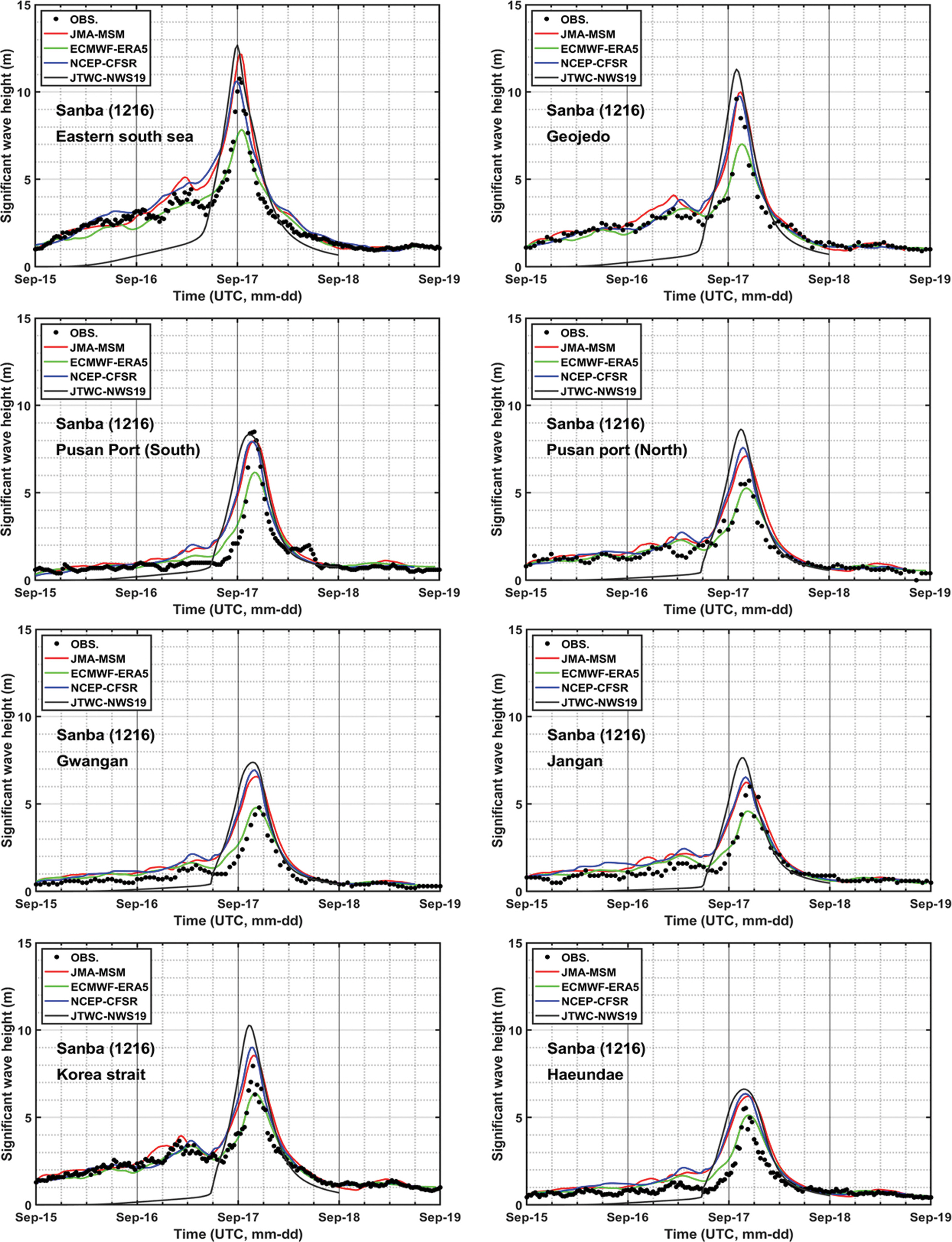
Fig. 12.Comparison of significant wave heights calculated using various wind fields against observed data at buoys on East Sea for Typhoon Sanba. 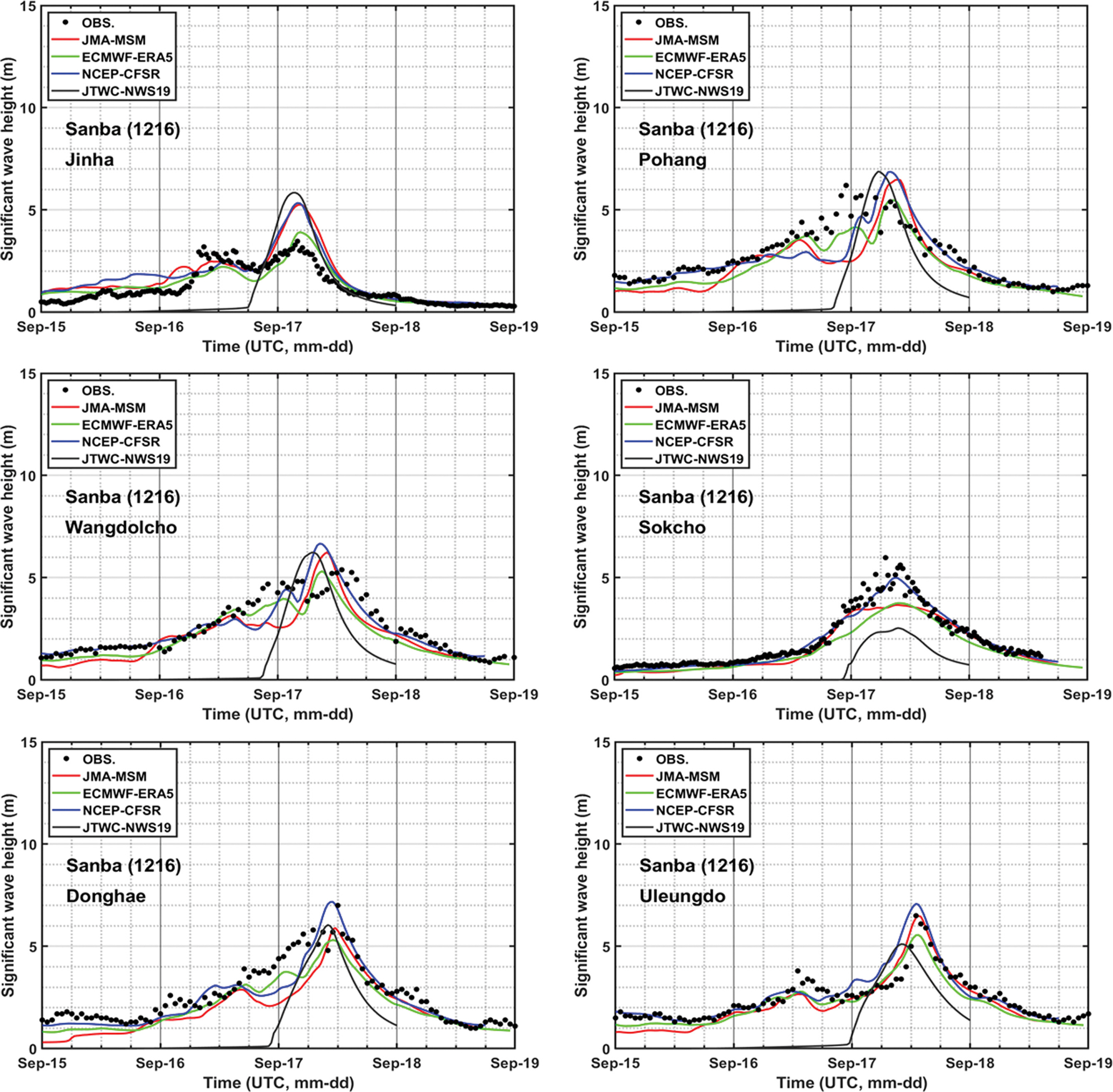
Fig. 13.Comparison of wind fields showing convergence belt on East Sea for Typhoon Sanba at 12:00 (UTC) on 17 Sept. 2012 (Unit, m/s): (a) JMA-MSM, (b) NCEP-CFSR, (c) ECMWF-ERA5, (d) JTWC-BT. 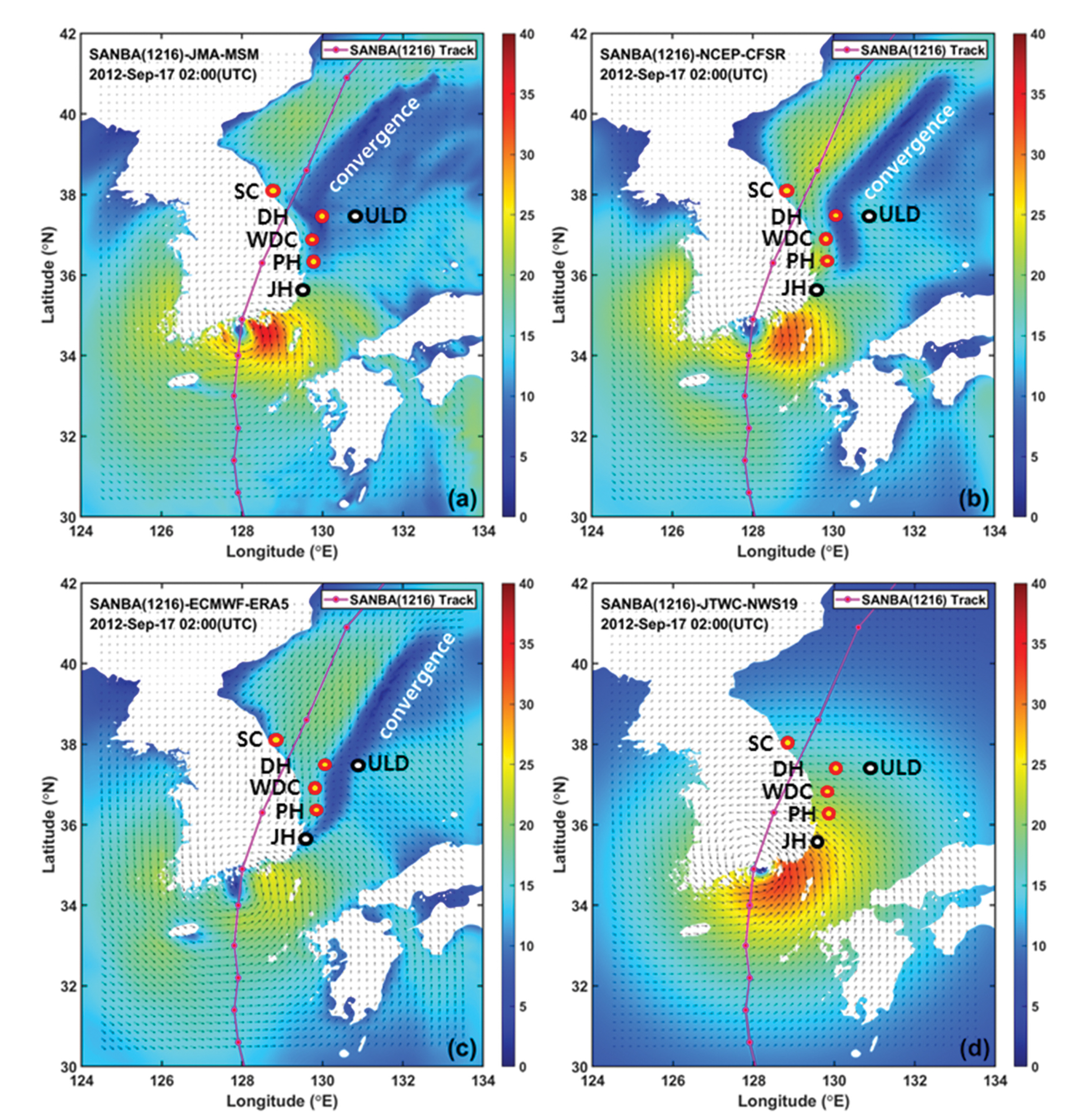
Fig. 14.Comparison of storm surge heights calculated using various weather fields against observed data at harbors along Jeju Island and south-western coast for Typhoon Sanba. 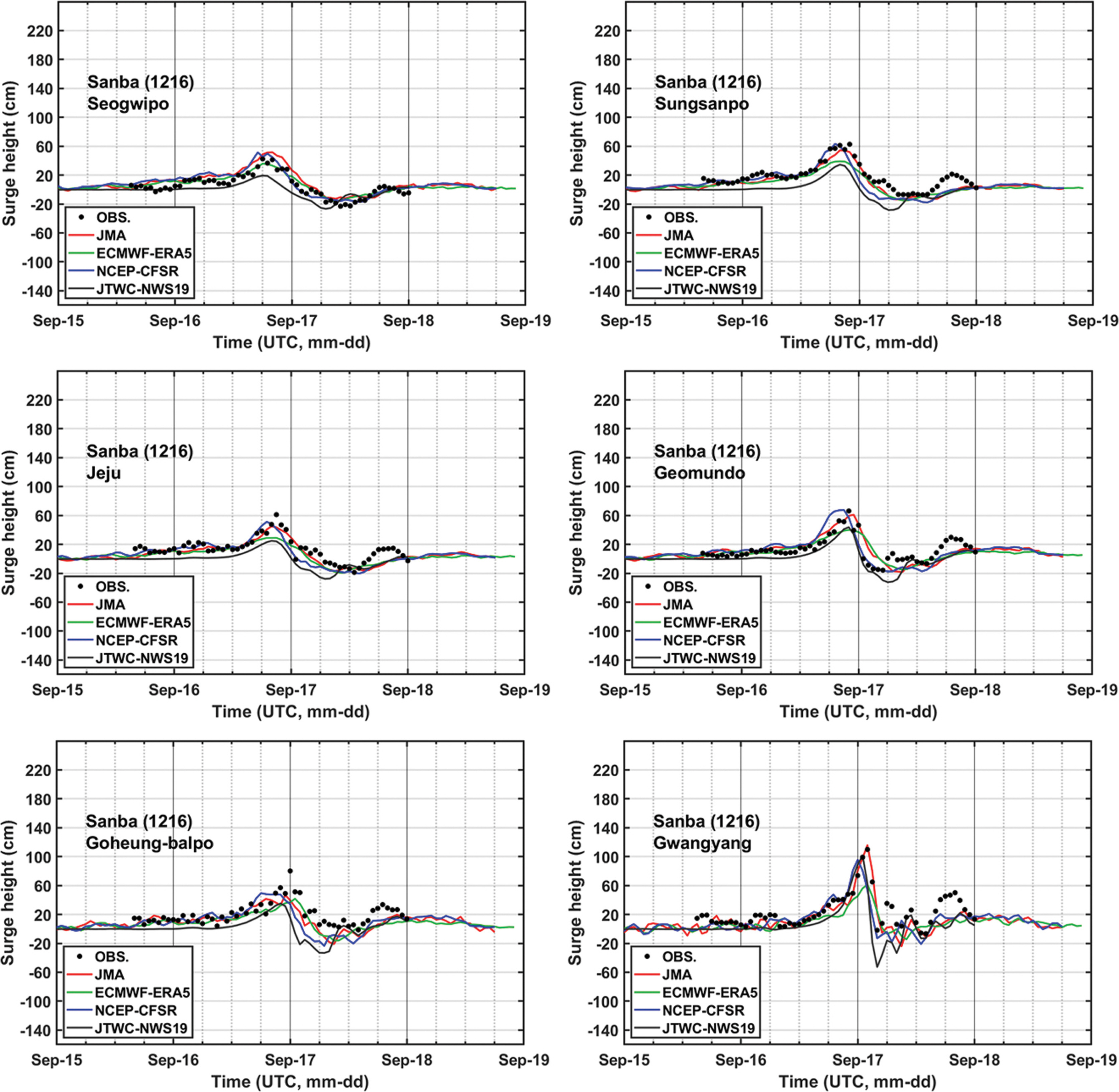
Fig. 15.Comparison of storm surge heights calculated using various weather fields against observed data at harbors along south-eastern coast for Typhoon Sanba. 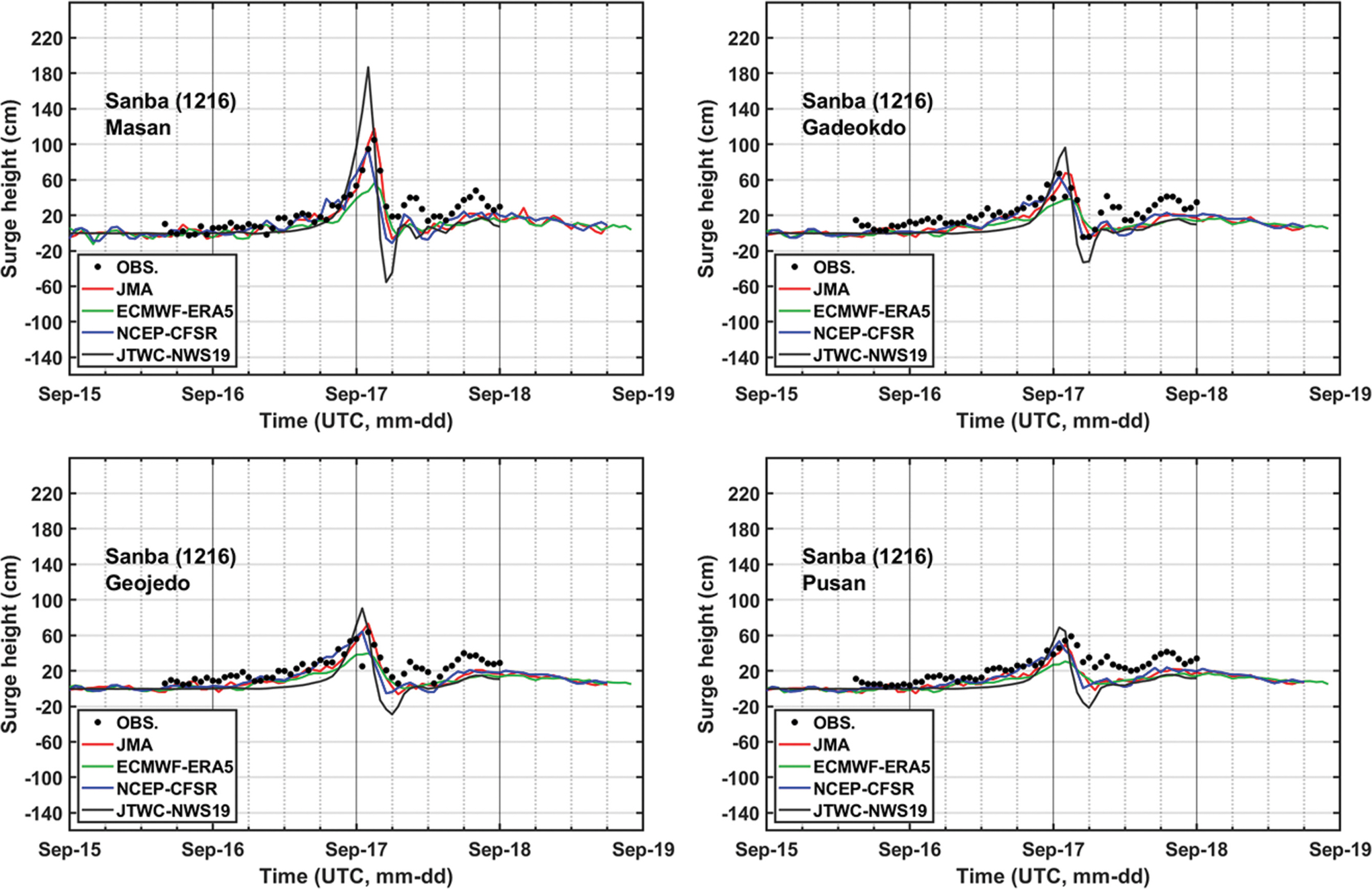
Fig. 16.Comparison of storm surge heights calculated using various weather fields against observed data at harbors along east coast for Typhoon Sanba. 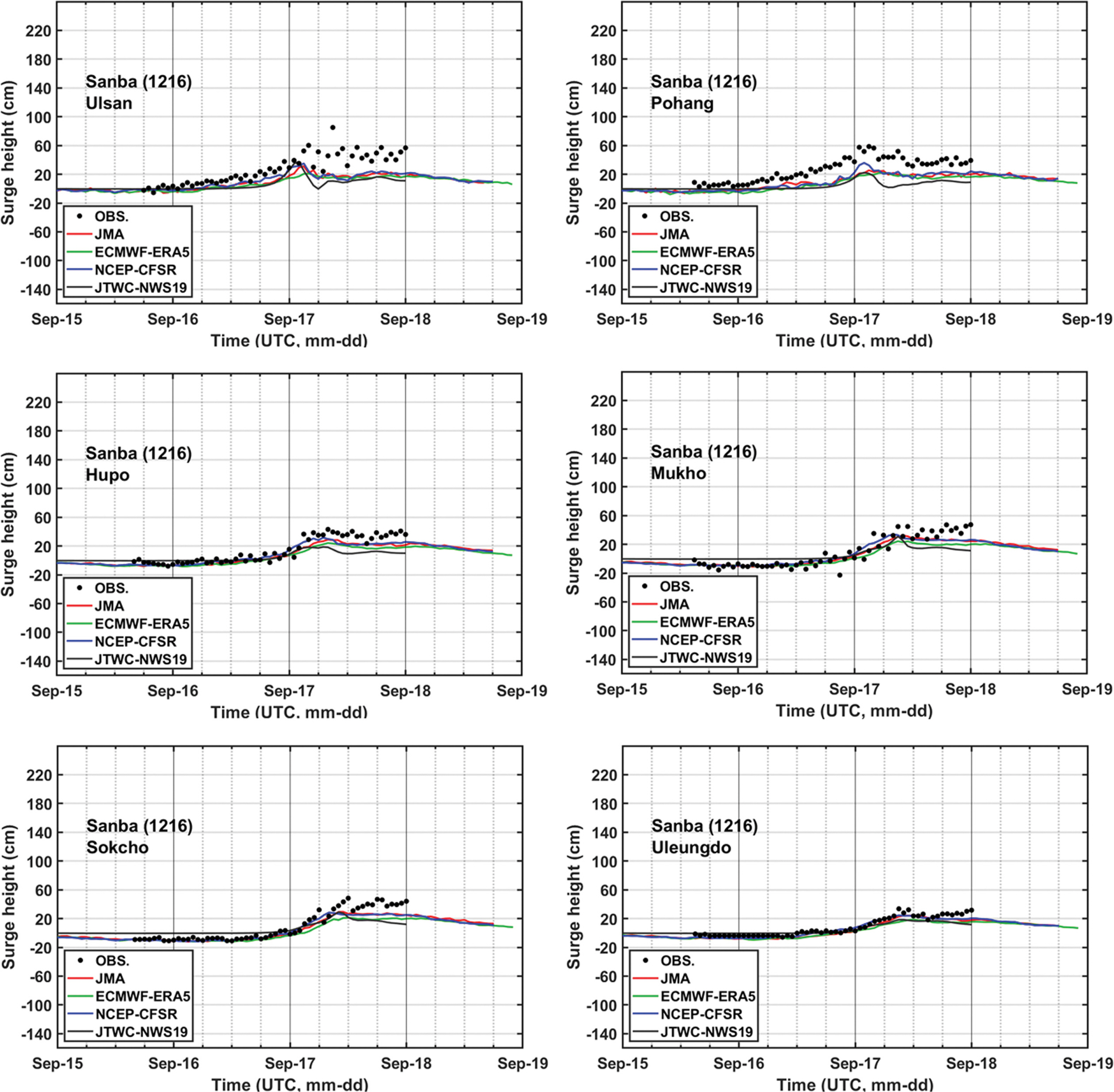
Fig. 17.Comparison of measured and calculated peak values associated with various weather fields: (a) significant wave height, (b) surge height. 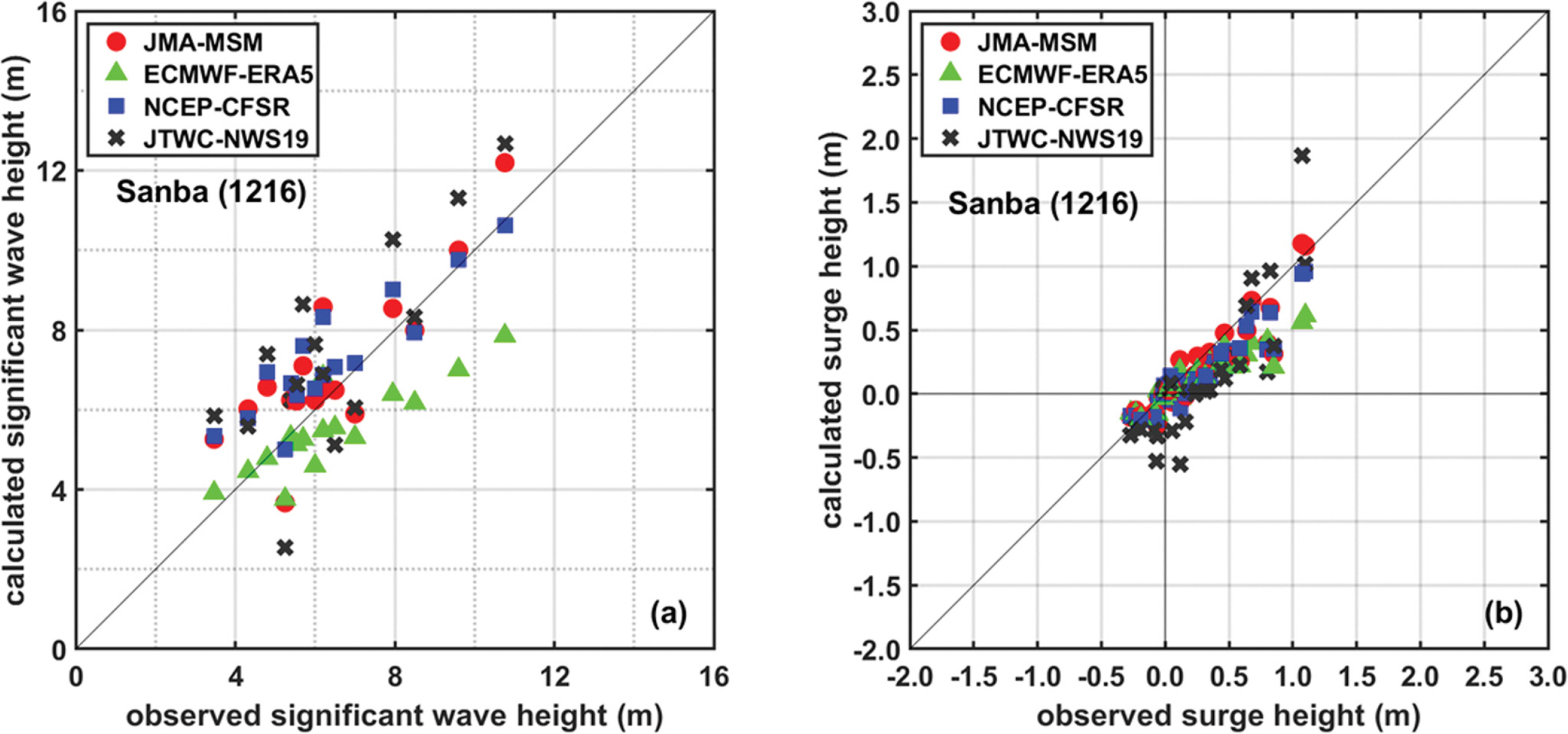
Table 1.List of forecast/reanalysis weather field data (Yoon et al., 2020)
ReferencesBooij, N., Ris, R.C., Holthuijsen, L.H (1999). A third-generation wave model for coastal regions, Part I, Model description and validation, J. Geophys. Res, 104(C4):7649-7666.
Hersbach, H. (Coauthors. 2020). The ERA5 global reanalysis, Quarterly Journal of the Royal Meteorological Society, 146, 1999-2049.
Jeong, WM. (2017). Private communication..
Kim, G.H., Ryu, K.H., Yoon, S.B (2020). Numerical simulation of storm surge and wave due to Typhoon Bolaven of 2012, Journal of Korean Society of Coastal and Ocean Engineers, 32(4):273-283 (in Korean)..
Komen, G.J., Hasselmann, S., Hasselmann, K (1984). On the existence of a fully developed wind sea spectrum, J. Phys. Oceanogr, 14, 1271-1285.
Korea Hydrographic and Oceanographic Agency. (2012). Oceanic abnormal phenomena report, Vol. 3 (in Korean).
Kwon, K.K., Jho, M.H., Yoon, S.B (2020). Numerical simulation of storm surge and wave due to Typhoon Kong-Rey of 2018, Journal of Korean Society of Coastal and Ocean Engineers, 32(4):252-261 (in Korean)..
Luettich, R, Westerink, J, Scheffner, N. (1992). ADCIRC: An advanced three-dimensional circulation model for shelves, coasts, and estuaries. Report 1. Theory and methodology of ADCIRC-2DDI and ADCIRC-3DL. Vicksburg MS: Coastal Engineering Research Center.
Luettich, R, Westerink, J, Scheffner, N. (1994). ADCIRC: An advanced three-dimensional circulation model for shelves, coasts, and estuaries. Report 2. User’s manual for ADCIRC-2DDI. Vicksburg MS: Coastal Engineering Research Center.
Saha, S. (Coauthors. 2010). The NCEP climate forecast system reanalysis, Bull. Amer. Meteor. Soc, 91, 1015-1057. 10.1175/2010BAMS3001.1.
Saha, S. (Coauthors. 2014). The NCEP climate forecast system Version 2, J of Climate, 27(6):2185-2208 doi: http://dx.doi.org/10.1175/JCLI-D-12-00823.1..
Saito, K. (Coauthors. 2006). The operational JMA nonhydro-static meso-scale model, Monthly Weather Review, 134, 1266-1298.
Suh, S.W., Kim, H.J (2012). Typhoon surge simulation on the west coast incorporating asymmetric vortex and wave model on a fine finite element grid, Journal of Korean Society of Coastal and Ocean Engineers, 24(3):166-178 (in Korean)..
SWAN team (2016). SWAN user manual (SWAN Cycle III version 41.10A), Delft University of Technology, 12-20.
|
|
|||||||||||||||||||||||||||||||||||||||||||||||||||||||||||||||||||||||